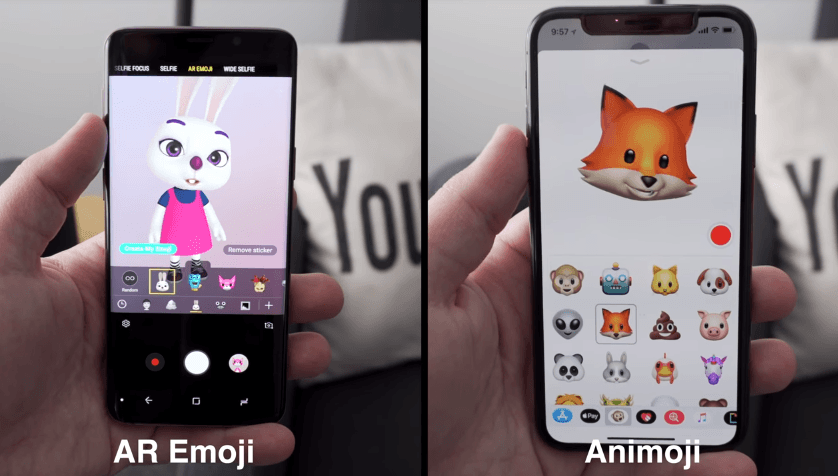Animoji is one of the most talked about features of the iPhone X. It uses the TrueDepth camera system to convert your facial movements into animated characters that you can share with your friends. Samsung has responded by introducing AR Emoji on the Galaxy S9. AR Emoji aims to serve the same purpose as Animoji, but the implementation is quite different. Let’s find out which one is better.
Animoji uses complex 3D sensors that analyze more than 50 different muscle movements to detect the movement of your eyebrows, lips, eyes, jaws, chin, and cheeks to create a realistic animated character of your facial expressions. The AR Emoji isn’t as advanced. It relies on the selfie camera and augmented reality software from a startup called Loom.ai. Notably, Loom.ai could license its technology to others, so we could see more Android phones with similar features in the near future.
Folks at MacRumors have compared the two in this video. The basic concept of both the AR Emoji and Animoji is to make the character on the screen mimic your facial movements. Since Apple uses 3D sensors to track your expressions, Animoji is far more efficient at picking up even subtle facial movements that AR Emoji can’t. AR Emoji has difficulty recognizing subtle movements such as a wink or an angry face, says MacRumors. Samsung’s technology is good enough to recognize exaggerated movements such as an open mouth or a blink, though.
The Animoji lives within the Messages app. You can create a 10-second video or a sticker from within the app and share it with your friends. In contrast, AR Emoji is found in the Galaxy S9’s camera app. While Animoji videos are limited to just 10 seconds, your AR Emoji can be as long as you want it to be. To set up AR Emoji, you have to launch the camera app, switch to AR Emoji mode, and take a photo of yourself smiling with your mouth closed. The Galaxy S9 uses machine learning algorithms on the picture to create an animated model of your face.
On the iPhone X, third-party apps such as Snapchat can take advantage of the TrueDepth camera system for filters that fit the face just right. The Snapchat filters and AR Emoji don’t look equally natural on the Galaxy S9, says MacRumors. Though both Animoji and AR Emoji require good lighting, AR Emoji struggles much more than Animoji when there is even slightly dim light.
MacRumors says the facial reactions on the Galaxy S9 seem “much more programmed” while the iPhone X makes your personality shine through the animated characters by tracking maximum detail. Samsung’s technology has its own set of strengths, though. For instance, you have tons of options to customize the characters with different hairstyles, skin tones, clothing, and more. Users also have the option to add stickers.
AR Emoji is more like Bitmoji than Animoji. You create an avatar of yourself and share them as PNGs and GIFs. It also has some pre-made GIFs to send to your friends. Sharing your AR Emoji is much easier than Animoji. You can share it via email, message, WhatsApp, Dropbox, etc as soon as you create it.
Since machine learning is built into AR Emoji, we can expect its tracking and accuracy to improve over time. Animoji has only a limited number of character options such as an alien, chicken, cat, monkey, fox, pig, robot, unicorn, rabbit, and poop. The Galaxy S9 has just three options currently: a cat, a blue bear, and a bunny. Samsung plans to bring Mickey Mouse and a few other characters soon. But the best thing about AR Emoji is that you can create a custom character modeled after your own face.
AR Emoji also includes a feature called Stickers. It is a lot like Snapchat filters. You can download more sticker packs or remove the downloaded ones by tapping on the “+” sign. The stickers allow you to add cute animal faces, sunglasses, and more to your face.
So, which one is better? The Galaxy S9’s AR Emoji wins hands down when it comes to customization options. But it lags behind the iPhone X when it comes to tracking, accuracy, and the underlying technology.
The Galaxy S9 and S9 Plus have been available for pre-order for the last couple of weeks. They would hit the store shelves on March 16, though Samsung has already started shipping the devices to pre-order customers. Both the Galaxy S9 and S9 Plus are incredibly powerful phones, but it makes more sense to pay a little extra and go for the larger version. The S9 Plus has a dual camera, a bigger battery, a larger screen space, and a higher RAM.





